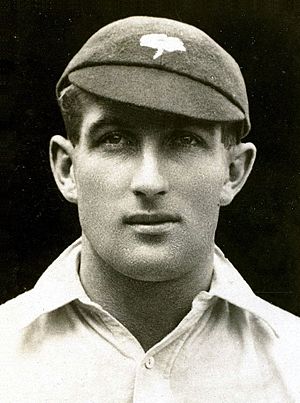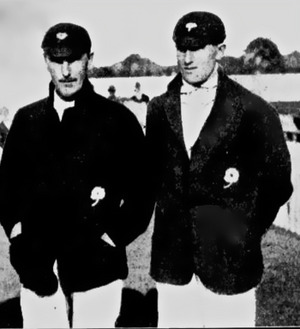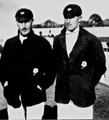Abe Waddington facts for kids

Abe Waddington c. 1920
|
||||||||||||||||||||||||||||||||||||||||
| Personal information | ||||||||||||||||||||||||||||||||||||||||
|---|---|---|---|---|---|---|---|---|---|---|---|---|---|---|---|---|---|---|---|---|---|---|---|---|---|---|---|---|---|---|---|---|---|---|---|---|---|---|---|---|
| Full name |
Abraham Waddington
|
|||||||||||||||||||||||||||||||||||||||
| Born | 4 February 1893 Clayton, Bradford, Yorkshire, England |
|||||||||||||||||||||||||||||||||||||||
| Died | 28 October 1959 (aged 66) Scarborough, Yorkshire, England |
|||||||||||||||||||||||||||||||||||||||
| Nickname | Abe | |||||||||||||||||||||||||||||||||||||||
| Batting | Right-handed | |||||||||||||||||||||||||||||||||||||||
| Bowling | Left-arm fast-medium | |||||||||||||||||||||||||||||||||||||||
| Role | Bowler | |||||||||||||||||||||||||||||||||||||||
| International information | ||||||||||||||||||||||||||||||||||||||||
| National side |
|
|||||||||||||||||||||||||||||||||||||||
| Test debut (cap 184) | 17 December 1920 v Australia | |||||||||||||||||||||||||||||||||||||||
| Last Test | 11 February 1921 v Australia | |||||||||||||||||||||||||||||||||||||||
| Domestic team information | ||||||||||||||||||||||||||||||||||||||||
| Years | Team | |||||||||||||||||||||||||||||||||||||||
| 1919–1927 | Yorkshire | |||||||||||||||||||||||||||||||||||||||
| Career statistics | ||||||||||||||||||||||||||||||||||||||||
|
||||||||||||||||||||||||||||||||||||||||
|
Source: ESPNCricinfo, 12 September 2010
|
||||||||||||||||||||||||||||||||||||||||
Abraham "Abe" Waddington (born 4 February 1893 – died 28 October 1959) was a professional cricket player from England. He played for Yorkshire and also for the England Test team. Abe played in two Test matches against Australia in 1920–21.
From 1919 to 1927, Waddington played 255 games for Yorkshire. Overall, he played 266 first-class cricket matches. He was a bowler who took 852 wickets with his left-arm fast-medium style. He was known for making the ball swing and for his smooth bowling action. Abe was a tough competitor and sometimes argued with umpires, which was unusual back then.
After World War I, Abe joined Yorkshire when the team needed new players. He quickly became important in 1919, taking 100 wickets and helping Yorkshire win the County Championship. He continued to play well in 1920 and was chosen to tour Australia. However, he didn't do as well in the Test matches there. He kept playing effectively for Yorkshire until injuries led him to retire in 1927. Besides cricket, he also played football as a goalkeeper and was a good amateur golfer.
Contents
Abe Waddington's Early Life
Abraham Waddington was born in Clayton, Bradford, England, on 4 February 1893. He was the oldest of three brothers. His family owned a business that refined fats, and his father, Sam, managed it. After school, Abe worked for the family business as a lorry driver.
He started playing cricket at age 11 for Crossley Hall. As a teenager, he played in the Bradford League for Lidget Green and then Laisterdyke. He became known as a good fast-medium bowler. In 1913, he helped Laisterdyke win the League championship. In 1914, he took 98 wickets for Wakefield. He even played for Yorkshire's second team in August 1914. But the start of the First World War stopped him from playing more for the county.
When the war began, Waddington joined the army. During the Battle of the Somme in 1916, he was injured by shrapnel. He found shelter with other wounded soldiers, including fellow Yorkshire cricketer Major Booth. Booth was badly hurt and died in Abe's arms. This sad event stayed with Waddington for the rest of his life. After recovering, Abe joined the Royal Flying Corps.
A First-Class Cricket Career
Joining the County Team
After World War I, the Yorkshire team needed new bowlers. Many players had retired or died in the war. Their main bowler, George Hirst, was also getting older. In 1919, Yorkshire struggled to win games.
Roy Kilner and Arthur Dolphin, two Yorkshire cricketers who had also been injured at the Somme, suggested Waddington to the team. Abe had been playing for Laisterdyke again. In July, he joined Yorkshire for a County Championship match against Derbyshire. In his first game, he took four wickets for 26 runs. In his second game, he took nine wickets against Essex, including his first five-wicket haul (taking five wickets in one innings).
After Waddington joined, Yorkshire's performance improved, and they won the Championship. Many people thought Abe's contribution was very important. He and Wilfred Rhodes formed a strong bowling team. Wisden Cricketers' Almanack, a famous cricket book, said Waddington bowled "left-hand, medium pace inclining to fast." They noted his smooth delivery and how he made the ball bounce sharply. Wisden called his first season "exceptional" and predicted he would achieve "great things." He took 100 wickets that season, which was a huge achievement for a debut player.
In 1920, Yorkshire finished fourth in the Championship. Waddington and Rhodes still did most of the bowling. Abe took 141 wickets that season. He had amazing performances against weaker teams. For example, he took 13 wickets for 48 runs against Northamptonshire, including a hat-trick. At the end of the season, he was chosen to tour Australia with the Marylebone Cricket Club (MCC).
Playing for England

The 1920–21 MCC tour to Australia was tough for the English team. They lost all five Test matches. Critics said England's bowling was weak, especially on Australia's hard pitches.
Before the tour matches began, Waddington had surgery for an infection and missed some early games. He played in the first Test match and took one wicket, but he didn't take any more and gave away many runs. He was also bothered by a leg injury. He played in only one more Test match. Overall, he took just one wicket in Test cricket for England.
The tour was frustrating for Abe. He found the heat difficult and didn't like that he played mostly in smaller, non-first-class games. The team's captain, J. W. H. T. Douglas, used Waddington differently than Yorkshire did. Douglas made him bowl long, defensive spells to save runs, which wasn't Abe's usual style. Because of his performance, Waddington never played for England again.
Back in England, Waddington continued to play well for Yorkshire. In 1921, he took 105 wickets. In 1922, Yorkshire won the first of four straight championships, and Abe took 133 wickets. He was very effective in important matches. Wisden said he was "more successful against strong sides than he had ever been before." He had his best career figures, taking eight wickets for 34 runs against Northamptonshire.
Later Career and Retirement
Waddington took over 100 wickets for the last time in 1925, with 109 wickets. Yorkshire won the championship again that year, thanks to their bowlers. In 1926, his performance dropped slightly, taking 78 wickets. He also scored his highest number of runs in a season, with 525 runs.
In 1927, Waddington's bowling declined further. He took 45 wickets, and Wisden said his "work was only occasionally worthy of his reputation." However, in his last season, he scored his only first-class century, making 114 runs against Worcestershire.
At the end of the 1927 season, Waddington was offered a new contract, but he turned it down. This ended his county cricket career. In total, he took 852 wickets and scored 2,527 runs in first-class matches. The next season, Yorkshire gave him a special payment of £1,000 as a thank you for his service.
Abe's Cricket Style and Personality
Waddington was a controlled bowler who could make the ball swing away from the batsman. He often bowled from around the wicket, starting his run-up from the on side and running behind the umpire. He released the ball from the corner of the bowling crease, creating a difficult angle for batsmen. He sometimes bowled short, fast deliveries.
Abe learned a lot from George Hirst, another left-arm fast bowler who coached him. However, they had very different personalities. Waddington was known for being quick-tempered. The cricket writer Neville Cardus called his bowling action "gloriously rhythmical" and "lovely."
Even though he scored a century, Waddington didn't reach his full potential as a batsman. He was a lower-order batsman who sometimes got out by playing risky shots. His friend and teammate Herbert Sutcliffe believed Abe had a beautiful batting style but lacked the patience to become a top batsman.
Waddington was known for being very competitive. He would sometimes question umpire decisions and talk to opposing batsmen, which was not common at the time. His obituary in The Times newspaper said he played to win and was very keen to appeal for wickets. Cricket historian Anthony Woodhouse described him as a "wild and irresponsible" person.
But Abe also had a different side. He was a good talker and liked to dress smartly. Herbert Sutcliffe said Abe was a "genial fellow in the dressing room" and often led discussions. The cricket writer Jim Kilburn said that at his best, Waddington was a "magnificently hostile bowler with one of the most beautiful actions."
Abe Waddington's Life After Cricket
After retiring from first-class cricket, Waddington took over his family's business. He continued to play cricket professionally in league games for a few years. He stayed friends with many Yorkshire players and even traveled to Australia with the England team in 1954–55, though not as a player. He visited Australia five times in total during his life.
Abe also had success in other sports. He was a good amateur football goalkeeper. He played seven matches for Halifax Town in the Football League during the 1921–22 season. He was also a skilled golfer and even played in qualifying rounds for the Open Championship in 1935 and 1939. His friend Sutcliffe said Abe had the talent to be a professional golfer. However, he was once banned from a golf club for pouring beer on the captain.
Waddington loved fast cars and motorcycles. He often went to the Isle of Man TT motorcycle race. His love for speed sometimes led to trouble with the police. In 1950, he was fined and banned from driving for a year. His lawyer said he was suffering from "overwork, worry and insomnia" at the time.
During the Second World War, Waddington worked for the Ministry of Food, helping to arrange the storage of fats. After the war, he was accused of being involved in a plan to cheat the Ministry of Food. However, he was found not guilty by a judge, who ruled there was no proof he knew about any wrongdoing.
Waddington was married twice. In 1925, he married Mabel Fawell. In 1952, he married Doris Garforth, and many of his old cricket friends attended this wedding. After a long illness, Abe Waddington died in a Scarborough nursing home on 28 October 1959, at the age of 66. He was cremated in Bradford.
Images for kids
-
Waddington (right) and Wilfred Rhodes on tour in Australia in 1920



